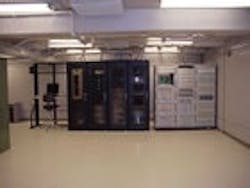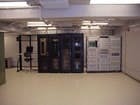County Unites All of its Environmental and Physical Equipment Monitoring Into One System
By Cam RogersTraditionally, IT networks are concentrated in large centralized data and telecommunications centers, which are manned on a 7x24 basis. However, with the distributed nature of today’s enterprise and the increase in outsourcing, the nature of mission-critical sites is changing. Mission-critical sites now include remote sites such as branch offices, Telco closets, POPs, cellular towers, call centers, outsourced collocation facilities, and other unmanned facilities. Securing and managing remote sites - especially the weakest link - is imperative in order to ensure overall IT network and system availability. Such was the challenge that Yakima County Technology Services faced in searching for a monitoring solution for its remote secure data center.
Yakima County Technology Services manages more than a thousand personal computers and phones, miles and miles of computer cable, and provides off-site monitoring services for other agencies. Its remote unmanned data center was designed and constructed to provide state and local agencies with the business continuity and disaster recovery services that they need. In addition, it is a host facility for shared business systems and computer services allowing jurisdictions with revenue challenges to effectively collaborate with others statewide.
This facility is located between two separate power grids that both feed the facility. A generator of sufficient capacity to power the entire county complex is installed and supplies conditioned power if utility power is interrupted. In addition, a 130 KVA Liebert UPS is installed and provides uninterruptible power for the first phase of the data center. Environmental requirements of the secure data center (temperature, air filtering, and humidity) are monitored and maintained with redundant HVAC units (with auto fail-over) engineered to meet the demands of the entire facility.
To manage the unmanned remote data center, Dean Heinen, WAN Administrator of Yakima County Technology Services, began to evaluate various solutions against the minimum requirements for a reliable, cost-effective monitoring solution that he defined:
Minimal capacity to handle 16 inputs, with both the flexibility and easy expandability to readily adapt to system changes and expansion as the needs grow.Integrated monitoring of both physical and environmental parameters from a unified view.Integration with Web-based cameras.Ability to accept standard 4-20mA sensor inputs, a common standard in industrial devices.Handle multiple relay output connections in order to interface directly and easily with the industrial devices that it controls.Dean found that several vendors met the criteria for minimal input capacity, integrated monitoring, and web camera support. However, most of the solutions were not designed for monitoring and controlling industrial equipment and devices in a mission-critical environment. For example, most manufacturers conduct input sensing by checking the change in voltage (from 0 to 5V). For industrial equipment and devices, input sensing via changes in current (i.e., 4-20mA) is the standard and provides greater accuracy and reliability, especially with long wire runs and/or in electrically "noisy" environments.
Yakima County Technology Services manages more than a thousand personal computers and phones, miles and miles of computer cable, and provides off-site monitoring services for other agencies. Its remote unmanned data center was designed and constructed to provide state and local agencies with the business continuity and disaster recovery services that they need. In addition, it is a host facility for shared business systems and computer services allowing jurisdictions with revenue challenges to effectively collaborate with others statewide.
This facility is located between two separate power grids that both feed the facility. A generator of sufficient capacity to power the entire county complex is installed and supplies conditioned power if utility power is interrupted. In addition, a 130 KVA Liebert UPS is installed and provides uninterruptible power for the first phase of the data center. Environmental requirements of the secure data center (temperature, air filtering, and humidity) are monitored and maintained with redundant HVAC units (with auto fail-over) engineered to meet the demands of the entire facility.
To manage the unmanned remote data center, Dean Heinen, WAN Administrator of Yakima County Technology Services, began to evaluate various solutions against the minimum requirements for a reliable, cost-effective monitoring solution that he defined:
Minimal capacity to handle 16 inputs, with both the flexibility and easy expandability to readily adapt to system changes and expansion as the needs grow.Integrated monitoring of both physical and environmental parameters from a unified view.Integration with Web-based cameras.Ability to accept standard 4-20mA sensor inputs, a common standard in industrial devices.Handle multiple relay output connections in order to interface directly and easily with the industrial devices that it controls.Dean found that several vendors met the criteria for minimal input capacity, integrated monitoring, and web camera support. However, most of the solutions were not designed for monitoring and controlling industrial equipment and devices in a mission-critical environment. For example, most manufacturers conduct input sensing by checking the change in voltage (from 0 to 5V). For industrial equipment and devices, input sensing via changes in current (i.e., 4-20mA) is the standard and provides greater accuracy and reliability, especially with long wire runs and/or in electrically "noisy" environments.
Dean chose RLE’s Falcon™ Monitoring system and sensors because it met his requirements "hands down." The Falcon™ solution provided a scalable enterprise solution that enabled Yakima County Technology Services to unite all of its environmental and physical equipment monitoring into one, manageable proactive system accessible from anywhere at anytime. With the Falcon™ solution, Dean and his team can proactively monitor all of their mission critical equipment at their remote facilities with a unified view via a simple web browser.The Falcon™ solution is easy to set up, flexible for expansion, and is designed to simply interface with industrial devices and equipment. Among the vendors and products that Dean evaluated, the RLE Falcon™ was the only product that measured inputs using 4-20mA current sensing, which is a standard for industrial environments. According to Dean, it was also the only system that provided "true" relay outputs that better interface with the devices it controls. Lastly, the Falcon™ is being used to support an "orderly managed shutdown" in the event of a power grid failure, generator failure, and/or UPS battery failure."RLE’s Falcon™ has become the heart of our monitoring system by giving real-time access to the health of our remote facilities infrastructure," comments Dean Heinen. Currently, within the remote data center, the Falcon™ monitors 19 devices and sensor parameters, including three doors using ADT proximity cards for access control, two indoor cameras, one generator, temperature, humidity, and seven parameters on the UPS such as battery level. As the offsite monitoring for other agencies grows, he foresees an even greater role that the Falcon™ will play as an integral part of his enterprise-wide remote monitoring services provided to other agencies and customers.

